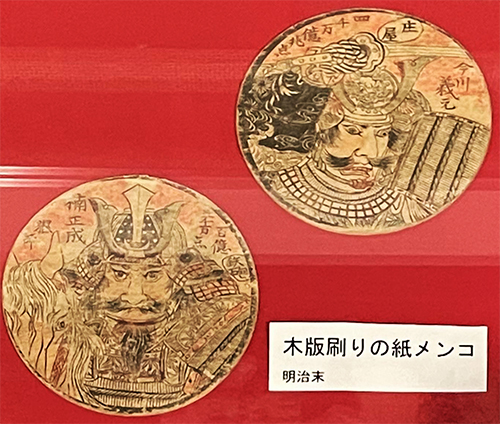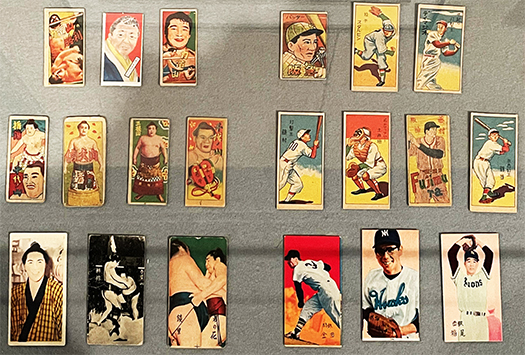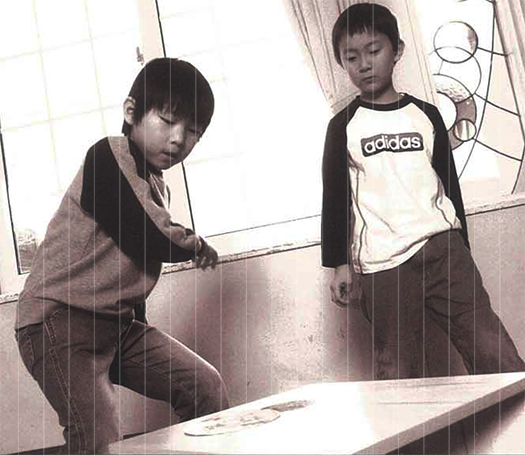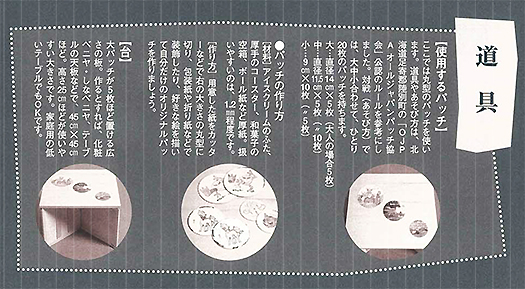

わたしが幼年期だったいまから60数年前当時、子どもたちは紙芝居に目が釘付けになる一方、冬場でも室内でカラダいっぱい使ったゲームとして「パッチ」に精を出していた。写真のような丸い厚紙に強そうなイラストが描かれたり、有名なプロスポーツ選手の写真などが印刷されたもの。北海道札幌では、このゲームのことをパッチと言っていたけれど、子ども同士のウワサで「メンコ」というのが東京ではあるらしい、という不思議な会話があった。
メディアが情報独占していた時代なのでWEBのように情報を自分で探索はできなかった。ジモティーたち同士ではそれ以上、詮索する方法も考えつかず、この不思議な「メンコ」という名前が頭の片隅でガン細胞化した。「東京に行ってみたい」という同年代少年少女たちの意識下の刷り込み起点に、このメンコへの疑問がとぐろを巻いていた。実際に東京に行ったらそういう意識下世界のことはまったく忘却されていたけれど(笑)。


<写真と図は公益財団法人さっぽろ青少年女性活動協会PDF資料より>
この解決不能のまま放置されてきた疑問がようやく解明された。結論はこのふたつの名称は同じゲームについての表現ということ。メンコという言葉はより始原的で漢字を当てるとすると「面子」だそうで、上の写真の2枚目のようなちょっと「馬面」を想像させるような縦長形状。遊び方としてはすぐ上の説明の遊び方になる。縦型のものはわたしは見たことがない。
遊び方が進化してくるとより「円形」の方が最適となるので徐々に主流になってくる。北海道のような鄙ではその遊び方がすぐに想起できる「パッチ」という呼称が一般化したものでしょう。わたしの8才上くらいの兄たちもメンコという名前は使っていなかったと聞いた。
しかしこの遊び、保育園で育った平成生まれの息子に聞いたら、平成の世でも生き長らえていたそうで保育園でやっていたようです。で、名前はメンコだったとのこと。
縦に長い日本列島、文化の中心地と鄙との間で、共通語と方言が生まれるけれど、そのつい最近の実例なのかと思い至った。
English version⬇
Menco and Patch: Questions from Dosan-ko about Postwar Children’s Culture – 3
Today’s topic is a time-limited Jimotei dialect story. Is this an actual example of the creation of a common language and dialect between the first source region of culture, the capital city and the remote and rural areas? …
When I was a child, more than 60 years ago, children were glued to picture-story shows and played “patch” indoors in the wintertime, using their whole bodies. The game was played on a round piece of cardboard, like the one in the photo, with strong-looking illustrations or pictures of famous professional athletes printed on it. In Sapporo, Hokkaido, this game was called “patch,” but there was a curious conversation among the children about a rumor that it was called “menko” in Tokyo.
In those days when the media had a monopoly on information, it was not possible to search for information by oneself, as was the case with the Web. The boys could not think of any way to inquire further, and the mysterious name “Menko” became a cancerous cell in a corner of their minds. The question of this menko was curling around the imprint of the boys and girls of the same age who wanted to go to Tokyo. When I actually went to Tokyo, I was completely oblivious to this subconscious world (laughs).
This question that has been left unanswered has finally been clarified. The conclusion is that the two names refer to the same game. The word “menko” is more primitive and is said to be “menko” in Chinese characters, and its vertical shape reminds one of a “horse’s face,” as shown in the second photo above. The way to play with it is as explained above. I have never seen a vertical one.
As the playing style evolves, the “circular” shape becomes more optimal and gradually becomes the mainstream. In remote areas such as Hokkaido, the name “patch” is probably more commonly used, as it immediately reminds people of this way of playing. I was told that my older brothers, who were about eight years older than me, did not use the name “menko” either.
However, when I asked my Heisei-born son who grew up in a nursery school about this play, he told me that it had survived even in the Heisei era and was played at the nursery school. He told me that the name of the game was Menko.
I wondered if this was a recent example of the common language and dialects that emerge between the cultural centers and the outlying areas of Japan’s long, vertical archipelago.
Posted on 2月 22nd, 2023 by 三木 奎吾
Filed under: 日本社会・文化研究







コメントを投稿
「※誹謗中傷や、悪意のある書き込み、営利目的などのコメントを防ぐために、投稿された全てのコメントは一時的に保留されますのでご了承ください。」
You must be logged in to post a comment.